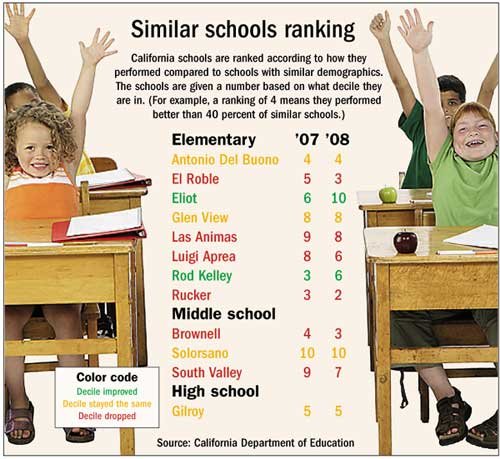The school district still has a lead on most districts with
similar demographics, but its edge decreased this past year,
according to state data. Ten of 12 district schools stagnated or
slipped in how they stack up compared to similar schools, but two
schools made significant gains.
The school district still has a lead on most districts with similar demographics, but its edge decreased this past year, according to state data. Ten of 12 district schools stagnated or slipped in how they stack up compared to similar schools, but two schools made significant gains.
Using data from last year, the California Department of Education recently ranked public schools on two scales, ranging from one to 10. The first compared all schools statewide and the second compared schools with similar demographics.
Unlike last year, when most Gilroy schools moved up compared to their peers, six schools shed a point or two this year and four stayed the same. On the other hand, Rod Kelley and Eliot elementary schools both boosted their rankings significantly.
Assistant Superintendent of Educational Services Basha Millhollen said she was alarmed to see that some schools – already not stacking up compared to similar schools – dropped this year. For example, Rucker Elementary School dropped from a three to a two.
“It’s up to the district to understand what changes occurred at the sites that lost similar schools ranking in order to provide the support needed to increase that ranking in the future,” she said.
But for schools like Las Animas Elementary, which dropped from a nine to an eight, Millhollen said she wasn’t concerned.
“To me, it’s not a dilemma,” she said, adding that scores of eight, nine and 10 keep schools competitive.
For the two middle schools that lost ground – South Valley, which slipped from a nine to a seven, and Brownell, which fell from four to three – Millhollen pointed to the population shift of students leaving for Solorsano. Both South Valley and Brownell are in Program Improvement – a federal designation that a school is not meeting testing standards. If a school has been in Program Improvement for at least two years, parents can request to transfer their child to a school that is not in Program Improvement. Last year, the district loosened its restrictions on transfers, resulting in the change in scores, Millhollen said.
Even though this year’s data was not as encouraging as last’s, Millhollen and Superintendent Deborah Flores said they welcome any information that will help them chart a course of action for a particular school.
“We don’t just say, ‘Oh dear, that’s too bad,'” Millhollen said. “We say, ‘Now what do we do?'”
Flores said she wants every district school to compare well to others like them but that, overall, she was pleased with this year’s rankings and pointed out how many of the district’s schools were ranked closer to the top of the scale than the bottom.
Of the district’s eight elementary schools, three middle schools and one high school that were ranked by the state, eight scored a five or above when compared to 100 similar schools and nine scored a five or above when compared to all other California public schools.
Although the Dr. T.J. Owens Gilroy Early College Academy and Gilroy’s only charter school – El Portal Leadership Academy – are too small to receive similar schools rankings, both were assigned a statewide ranking. The early college academy was the only school in the district to earn a 10, while El Portal was the only school to receive a one.
Two bright spots on the district’s report card were Rod Kelley and Eliot elementary schools, which added three and four points, respectively, to their similar schools ranking. With a score of 10, Eliot joined Ascencion Solorsano Middle School as Gilroy’s only schools to achieve a top ranking.
“Oooo, nice,” Eliot Principal James Dent said when he heard the news. “Being a 10 is obviously what everyone is striving for. It tells us that the job we’re doing is noteworthy.”
Not only did the school ramp up its similar schools ranking under his wing, it also tacked a county-leading 85 points onto its score on the Academic Performance Index – a state measure of performance on a standardized test. This brought the school’s score to 759, nearing the state target of 800.
Quick to hand the credit off to his teachers and students, “it’s a great testament to what they’re able to accomplish,” Dent said.
Rod Kelley Principal Luis Carrillo is also patting his staff on the back for a job well done. He largely credited a schoolwide reading initiative for his school’s success.
“This is big,” he said. “Everything revolves around reading. Our emphasis is on reading first.”
With literacy-inspired events like Dr. Seuss Day and the school’s authors fair peppering the school year and a revamped homework routine giving students more time to focus on their reading, Carrillo hopes to continue seeing his school’s scores rise. This year, their similar schools ranking rose from three to six.
Although most principals are holding their breath for their students’ scores on this year’s tests due to be released this summer, all of the material the state recently released paints a picture of where a school stands in terms of achievement, said Jim Pisano, the director of student assessment and program evaluation. The similar schools ranking is one of the “most telling” indicators, and are the kinds of numbers that attract prospective home buyers to high-achieving neighborhood schools, Pisano said.












